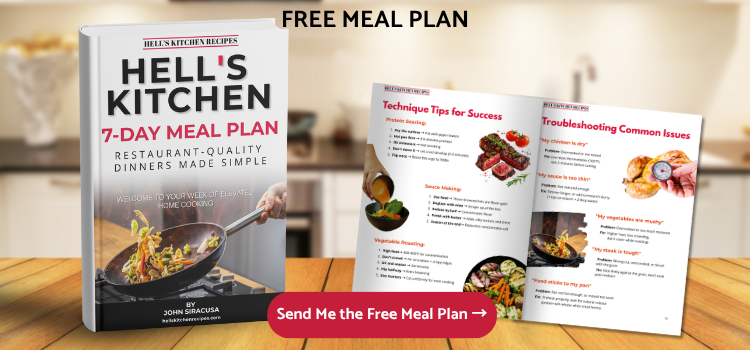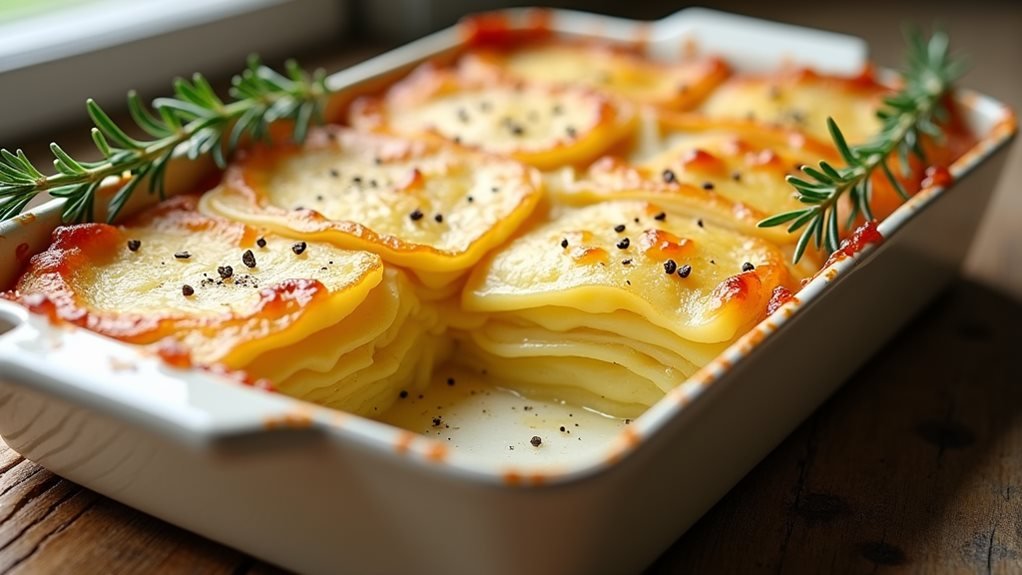There is an avalanche of knife designs, each with its unique specialization. Knifemakers are also constantly churning out new designs to fill gaps you might never notice. Their functionalities often crisscross each other, and you will find knives that can perform multiple tasks while others specialize in a single critical function.
Large chef’s knives can be used for various tasks such as cutting meat, dicing vegetables, slicing herbs, and chopping nuts. Carving knives are ideal for slicing dense meats, while knives work best for thinner roast, fruit, and vegetable slices.
Instead of buying a selection of specialist knives you will never use, it is better to know the functional features of different kitchen knives and the most popular types of kitchen knives and their application. Doing so helps you pick only what you need. I’m also not so big on using a knife for just one thing, as I feel it wastes resources.
Understanding the Different Types of Kitchen Knives and Use
Choosing the right knife is essential for any home chef looking to create delicious and visually appealing dishes. With so many kitchen knives available, knowing which ones to use for specific tasks can be overwhelming. Each knife has unique features and uses, from the versatile chef’s knife to the thin paring knife.
- Chef’s Knife
- Santoku Knife
- Carving Knife/Slicing Knife
- Bread Knife
- Utility Knife
- Boning Knife
- Paring Knife
- Meat Cleaver/ Butcher Knife
- Tourné Knife
- Filleting Knife
- Salmon Knife
- Nakiri Knife
- Tomato Knife
Knowing the different types of kitchen knives and their uses is crucial for any aspiring home chef. Each knife has unique features and functions, allowing for precise and efficient cutting, slicing, and chopping. Whether you’re a beginner or a seasoned pro, understanding how to use the right knife for the job will help you take your culinary skills to the next level and create visually stunning and delicious meals that are sure to impress.
1. Chef’s Knife

Buy: Victorinox Fibrox Pro 8-Inch Chef’s Knife on Amazon
These knives are typically eight to ten inches long with a long and broad blade. The blade has a straight cutting edge that is widest across the heel and rounds at the tip to make the knife pointed. The curved edge allows you to rock the knife back and forth on your cutting board, which is a comfortable and efficient technique.
The relatively large size of the blade and its cutting efficiency make the chef’s knife a versatile component of any kitchen assembly. You can chop and dice numerous vegetables, fruits, and herbs in one setting.
The broad heel area enables you to exert more pressure on the heavy-duty cuts without risking your fingers, so you can also use them for hard foods like sweet potatoes, onions, or parsnips. You can also use them on other ingredients like meat, poultry, and fish.
2. Santoku Knife

Buy: DALSTRONG 7-Inch Gladiator Series Santoku Knife on Amazon
These knives have a narrow sheep’s foot blade with a straight edge. The lightweight and narrow blade makes them ideal for precision work than your regular chef’s knife. They can make thinner cuts as the narrow blade reduces how much you need to push the food away as you cut.
The blades come with small indentations or dimpling, making it easy for food to slide off.
Santoku knives are versatile in their application (their native Japanese name was santoku bocho which translates to “three uses”). They will make excellent sushi as the side dimpling prevents food items from sticking to the knife.
The broad blade is also great for chopping, dicing, and mincing ingredients like vegetables and has even been successfully used to slice cheese by our chefs. The Santoku knife is a great alternative to a chef’s knife if you only have one knife in your kitchen.
3. Carving Knife/Slicing Knife

Buy: Victorinox Fibrox Pro Swiss Army Slicing Knife on Amazon
The carving knife comes with a long and narrow blade. The narrow width helps precision cutting and reduces the drag as it cuts through meats for clean and uniform slices. The extended length enables the carving knife to slice through wide pieces. Some of them have indentations on the side, making it easy for them to release the slices.
You’ll use the knife mainly when there are large cuts of cooked meat like beef, lamb, pork, or roasted turkey to be served. It empowers you to produce neat, lean, and evenly-sized slices. It can also come in handy when tackling larger fruits and vegetables like zucchini or melons, which present a challenge for smaller or broader knives.
4. Bread Knife

Buy: Mercer Culinary Millennia Bread Knife on Amazon
This kitchen knife type features a long blade with serrated edges designed to see through a wide range of bread, whether soft, crusty, bread rolls, bagels, or any other you can think of, without compromising their integrity. The knives are also good with baked goods like cake and breaking chocolate bars into smaller pieces (see also ‘Homemade Baked Beans and Potato Cakes ‘).
They also help with soft fruits, like tomatoes, when you want to cut through the skin without damaging the structure of the fruit. You will also appreciate a bread knife cutting through large melons, as other blades tend to get stuck there.
For a serrated knife to perform as intended, you should use a sawing motion instead of the rocking motion recommended for other knives. You want the end product intact, and pressing against it won’t do.
5. Utility Knife

Buy: Henckels Solution 6-Inch Utility Knife on Amazon
Similar to chef’s knives in shape, but are smaller and slimmer, making them suitable for more intricate cuts. They are generally larger than paring knives, though. They might come with serrated edges or straight edges, and some have sharp tips that taper upwards towards their spines. These unique features make them suited for specific tasks.
Utility knives are great when working with smaller ingredients that require a level of accuracy that the larger chef’s knives can’t handle. The serrated versions will be ideal for slicing sandwiches; straight edges can peel produce or cut and chop onions, small to mid-sized vegetables, and meat cuts.
6. Boning Knife

Buy: Wüsthof Classic 5-Inch Boning Knife on Amazon
This knife has a narrow blade with a sharp edge and tapers to a pointed tip. It is relatively short at approximately six inches from point to butt. It is light and maneuverable by design to enhance comfort and make it easy to use. Depending on the designated role, the blade can be flexible or rigid.
These kitchen knives are quite adept at deboning cuts of meat and will eliminate wastage. The rigid blades can trim cartilage or cut through connective tissues and joints without destroying the cut. Their pointed tips and slim blades get them through spaces broader blades cannot reach so that they can separate the flesh from bone neatly.
The flexible blades are good for cutting around bones without ruining the surrounding flesh. They are suitable for poultry and can also be used to remove the skin from fish as they make it easy to separate the delicate flesh.
7. Paring Knife

Buy: Mercer Culinary Genesis 3.5-Inch Paring Knife on Amazon
This small-sized knife has a thin, slim, evenly-sized blade that is super sharp and has a pointed tip. The knives are typically lightweight to facilitate handling when executing intricate cuts, some done off the cutting board. They might have a straight or serrated edge, depending on what they were designed for.
Their original application was peeling fruits and vegetables, which they do a bang-up job of because their small profiles make it possible to avoid cutting large chunks of flesh. They are also lightweight, which means they can be held comfortably with one hand as the other holds the ingredients (which is how most fruits are peeled).
These qualities make them excellent for hulling and coring fruits and vegetables, removing seeds, slicing fruits, and even deveining shrimp or prawns. Deveining requires precise cuts and extraction so that you don’t contaminate the rest of the food with the contents of the veins.
8. Meat Cleaver/ Butcher Knife
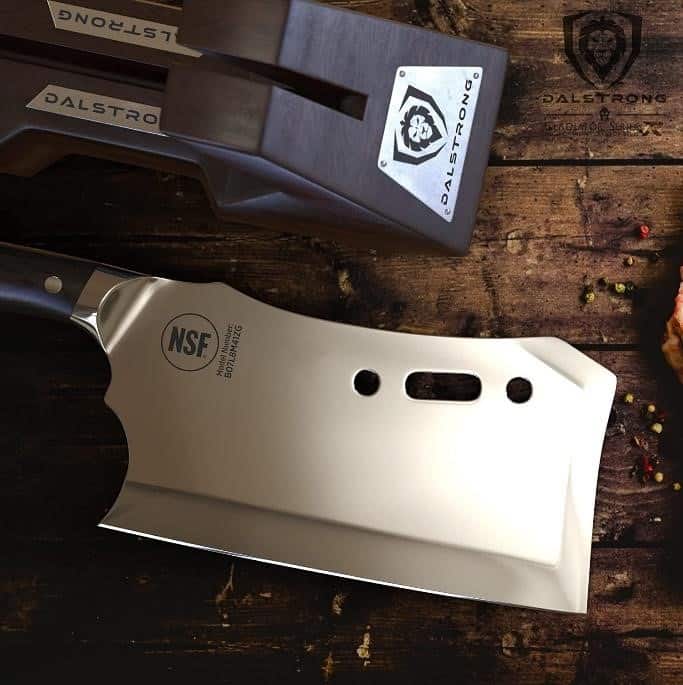
Buy: DALSTRONG Gladiator Series 9-Inch Obliterator Cleaver on Amazon
This large knife has a flat, rectangular-shaped blade. They come in various sizes and weights, so you can choose the one that is comfortable for you or most suited for your intended purposes. They occasionally have a hole near the spine that you can use to hang them when they are not in use.
The meat cleaver is primarily used to chop raw meat and can even cut through bone, which is great for preparing raw meat. You can also use the flat side for crushing ginger or garlic against a cutting board to make it easier to remove the peel before mincing.
9. Tourné Knife
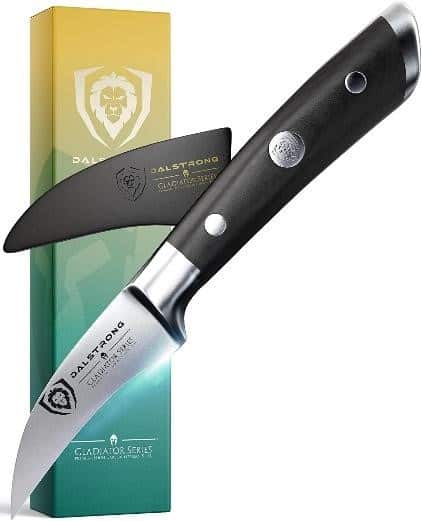
Buy: DALSTRONG Gladiator Series 2.75-Inch Tourné Paring Knife on Amazon
This knife produces the tourné cut, a special cut applied to vegetables like carrots, zucchini, potatoes, and squash, among others, to give them a distinctive and consistent appearance as an ingredient. The cut gives these ingredients a uniform round figure, enhancing their presentation and allowing them to cook more evenly because they will rotate better in a cooking pan.
A tourné knife is a paring knife whose short blade is curved like a bird’s beak and ends with a sharp tip. It handles round objects efficiently that you can’t replicate with a straight-bladed knife. The knife makes creating round shapes or handling round ingredients seem easy.
They are also good for peeling onions and shallots because their sharp tips score the skins as the slim blades slip under the papery hulls. You can undress them with a record few easy strokes. The same concept applies to ginger root or peeling citrus for dessert or drinks.
Watch this lesson on how to tourné potatoes by the experts from Le Cordon Bleu to get a feel of the tourné knife.
10. Filleting Knife
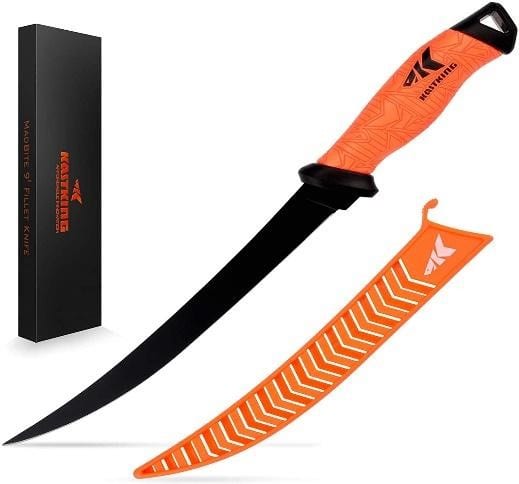
Buy: KastKing Professional Fillet Knife on Amazon
This long, thin knife has a flexible, razor-sharp blade and a finely pointed tip. It resembles a boning knife, but the blade is more flexible and thinner.
The pointed tip easily pierces through skin, leaving the sharp blades to glide through with ease for clean cuts. Its flexibility allows it to bend without breaking as you slice so that you can get as close to the bone as possible. Their blades are typically six to eleven inches long, although the optimal length will vary depending on the size of the food.
The designated role for these knives is filleting fish, but you can also use them on beef tenderloins, chicken fillets, and to devein shrimp or prawns. Their flexibility ensures you will not damage the delicate fish flesh. They can also be wielded horizontally instead of vertically when you need to cut around the backbone of the whole fish to produce great fillets.
11. Salmon Knife

Buy: Wüsthof Classic 12-Inch Hollow Edge Salmon Slicer on Amazon
These kitchen knives feature long, slender, grounded blades with rounded tips. The blades often have notches along the sides to prevent ingredients from sticking to the knife and reduce drag while cutting. The slim and sharp blades make them adept at precision cutting, so they will fit between the skin and flesh without damaging the delicate meat.
They are designed for filleting larger fish and will also be used to cut and serve very thin slices of salmon and tuna. The thin, flexible, dimpled, and grounded blades make them excellent for slicing ham, portioning cooked dishes, and sectioning pastries and cakes. Their rounded tips prevent accidental damage to the flesh as you cut.
12. Nakiri Knife

Buy: Zwilling Twin Signature 7-Inch Vegetable Cleaver on Amazon
This knife is distinguishable by its broad, rectangular, straight blade, with a flat edge and rounded tip. It resembles a meat cleaver but is lighter, and the blade is thinner. The edges are typically hollow ground and very sharp.
Your butternut squash and sweet potatoes will be cut as sleek as butter. They are designed for the push and pull of chopping vegetables with a flat edge whose entire length touches the cutting board at once and adds weight which helps the knives fall through ingredients easier. It reduces the force you must apply to produce clean cuts of hard-to-chop or root veggies.
The thin blades will easily handle the kind of delicate vegetables which would squish under thicker blades. Nakiri knives can create thin, even slices of veggies like cabbage and lettuce, making beautiful ribbons for garnish.
13. Tomato Knife

Buy: Wüsthof Classic 5-Inch Tomato Knife on Amazon
Tomatoes have a soft, fleshy interior and a hard exterior with delicate skin. This requires a specialized cutting tool to maintain its integrity which comes in the form of a tomato knife.
This knife is lightweight and has a small profile that allows you to manipulate it with one hand. It has a short blade with a sharp, serrated cutting edge whose tip has two points instead of one, giving it a forked look.
The serrated edge will catch onto the tomato’s skin firmly, unlike straight edges, which might slip around and cause a mess. It enables you to see through the length of the tomatoes without damaging their structure. You don’t need to apply pressure that might crush the flesh or squish them.
The double points let you delicately lift the cut tomato without damaging the flesh. They also make it easy to core tomatoes, as some recipes require, leaving their structure intact.
Tomato knives are essential for preparing foods where the tomatoes will remain visible in the final presentation, like salads, pizzas, and numerous tomato garnishes.
Our Take
The right combination of tools to enjoy your time in the kitchen while delivering world-class entrées. This is especially critical with knives because they determine your efficiency, speed, and the quality of ingredients you will end up with after your food prep.
Prioritize what you constantly cook to create a wholesome list of knives you will use, then add to your collection in order of priority. Repeated usage will justify the acquisition and ensure you get value for your money.



